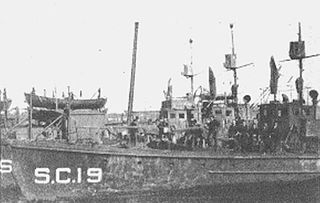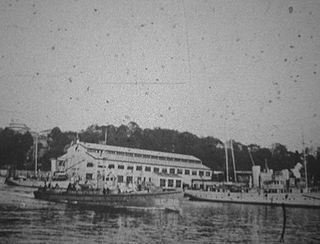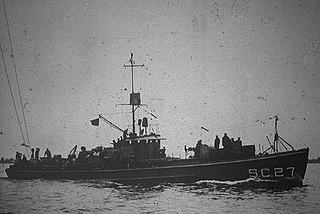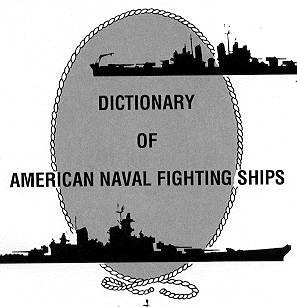 | |
| History | |
|---|---|
| Name: |
|
| Builder: | Naval Station New Orleans, New Orleans, Louisiana |
| Commissioned: | 19 February 1918 |
| Fate: | Sold 19 March 1920 |
| General characteristics | |
| Class and type: | SC-1-class submarine chaser |
| Displacement: |
|
| Length: |
|
| Beam: | 14 ft 9 in (4.50 m) |
| Draft: |
|
| Propulsion: | Three 220 bhp (160 kW) Standard Motor Construction Company six-cylinder gasoline engines, three shafts, 2,400 US gallons (9,100 L) of gasoline; one Standard Motor Construction Company two-cylinder gasoline-powered auxiliary engine |
| Speed: | 18 knots (33 km/h) |
| Range: | 1,000 nautical miles (1,900 km) at 10 knots (19 km/h) |
| Complement: | 27 (2 officers, 25 enlisted men) |
| Sensors and processing systems: | One Submarine Signal Company S.C. C Tube, M.B. Tube, or K Tube hydrophone |
| Armament: |
|
USS SC-4, during her service life known as Submarine Chaser No. 4 or S.C. 4, was an SC-1-class submarine chaser built for the United States Navy during World War I.

A submarine chaser is a small and fast naval vessel that is specifically intended for anti-submarine warfare. Many of the American submarine chasers used in World War I found their way to Allied nations by way of Lend-Lease in World War II.

The United States Navy (USN) is the naval warfare service branch of the United States Armed Forces and one of the seven uniformed services of the United States. It is the largest and most capable navy in the world and it has been estimated that in terms of tonnage of its active battle fleet alone, it is larger than the next 13 navies combined, which includes 11 U.S. allies or partner nations. with the highest combined battle fleet tonnage and the world's largest aircraft carrier fleet, with eleven in service, and two new carriers under construction. With 319,421 personnel on active duty and 99,616 in the Ready Reserve, the Navy is the third largest of the service branches. It has 282 deployable combat vessels and more than 3,700 operational aircraft as of March 2018, making it the second-largest air force in the world, after the United States Air Force.

World War I, also known as the First World War or the Great War, was a global war originating in Europe that lasted from 28 July 1914 to 11 November 1918. Contemporaneously described as "the war to end all wars", it led to the mobilisation of more than 70 million military personnel, including 60 million Europeans, making it one of the largest wars in history. It is also one of the deadliest conflicts in history, with an estimated nine million combatants and seven million civilian deaths as a direct result of the war, while resulting genocides and the 1918 influenza pandemic caused another 50 to 100 million deaths worldwide.
SC-4 was a wooden-hulled 110-foot (34 m) submarine chaser built at Naval Station New Orleans in New Orleans, Louisiana. She was commissioned on 19 February 1918 as USS Submarine Chaser No. 4, abbreviated at the time as USS S.C. 4.

A hull is the watertight body of a ship or boat. The hull may open at the top, or it may be fully or partially covered with a deck. Atop the deck may be a deckhouse and other superstructures, such as a funnel, derrick, or mast. The line where the hull meets the water surface is called the waterline.
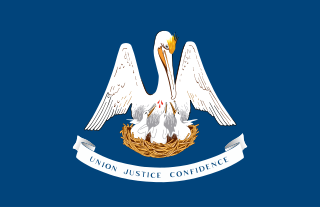
Louisiana is a state in the Deep South region of the South Central United States. It is the 31st most extensive and the 25th most populous of the 50 United States. Louisiana is bordered by the state of Texas to the west, Arkansas to the north, Mississippi to the east, and the Gulf of Mexico to the south. A large part of its eastern boundary is demarcated by the Mississippi River. Louisiana is the only U.S. state with political subdivisions termed parishes, which are equivalent to counties. The state's capital is Baton Rouge, and its largest city is New Orleans.
Ship commissioning is the act or ceremony of placing a ship in active service, and may be regarded as a particular application of the general concepts and practices of project commissioning. The term is most commonly applied to the placing of a warship in active duty with its country's military forces. The ceremonies involved are often rooted in centuries old naval tradition.
During World War I, S.C. 4 served in the Special Hunting Squadron, USS Salem Group, on antisubmarine patrol duty against German submarines in the Gulf of Mexico, and was based at Key West, Florida.
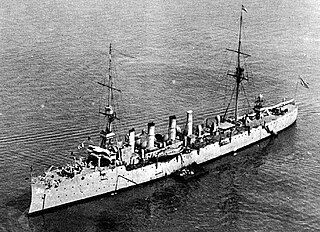
USS Salem (CS-3/CL-3), Scout Cruiser No. 3, was a Chester-class scout cruiser of the United States Navy. She was the first Navy ship named for the city of Salem, Massachusetts.

The German Empire, also known as Imperial Germany, was the German nation state that existed from the unification of Germany in 1871 until the abdication of Kaiser Wilhelm II in 1918.

The Gulf of Mexico is an ocean basin and a marginal sea of the Atlantic Ocean, largely surrounded by the North American continent. It is bounded on the northeast, north and northwest by the Gulf Coast of the United States, on the southwest and south by Mexico, and on the southeast by Cuba. The U.S. states of Texas, Louisiana, Mississippi, Alabama, and Florida border the Gulf on the north, which are often referred to as the "Third Coast", in comparison with the U.S. Atlantic and Pacific coasts.
On 19 March 1920, the Navy sold S.C. 4 to David A. Clarkson of Nassau in the Bahamas.

Nassau is the capital and commercial centre of the Commonwealth of the Bahamas. The city has an estimated population of 274,400 as of 2016, just over 70% of the population of the country (≈391,000). Lynden Pindling International Airport, the major airport for the Bahamas, is located about 16 kilometres (9.9 mi) west of Nassau city centre, and has daily flights to major cities in Canada, the Caribbean, the United Kingdom and the United States. The city is located on the island of New Providence, which functions much like a business district. Nassau is the site of the House of Assembly and various judicial departments and was considered historically to be a stronghold of pirates. The city was named in honour of William III of England, Prince of Orange-Nassau, deriving its name from Nassau, Germany.

The Bahamas, known officially as the Commonwealth of The Bahamas, is a country within the Lucayan Archipelago. The archipelagic state consists of more than 700 islands, cays, and islets in the Atlantic Ocean, and is located north of Cuba and Hispaniola, northwest of the Turks and Caicos Islands, southeast of the U.S. state of Florida, and east of the Florida Keys. The capital is Nassau on the island of New Providence. The designation of "the Bahamas" can refer either to the country or to the larger island chain that it shares with the Turks and Caicos Islands. The Royal Bahamas Defence Force describes the Bahamas territory as encompassing 470,000 km2 (180,000 sq mi) of ocean space.
The U.S. Navy adopted its modern hull number system on 17 July 1920. Although Submarine Chaser No. 4 had already been sold by then, since that date she has been referred to retrospectively as USS SC-4 - the shortened name she would have received under the new system had she still been in Navy service at that time.
The United States Navy, United States Coast Guard, and United States National Oceanic and Atmospheric Administration (NOAA) use a hull classification symbol to identify their ships by type and by individual ship within a type. The system is analogous to the pennant number system that the Royal Navy and other European and Commonwealth navies use.




